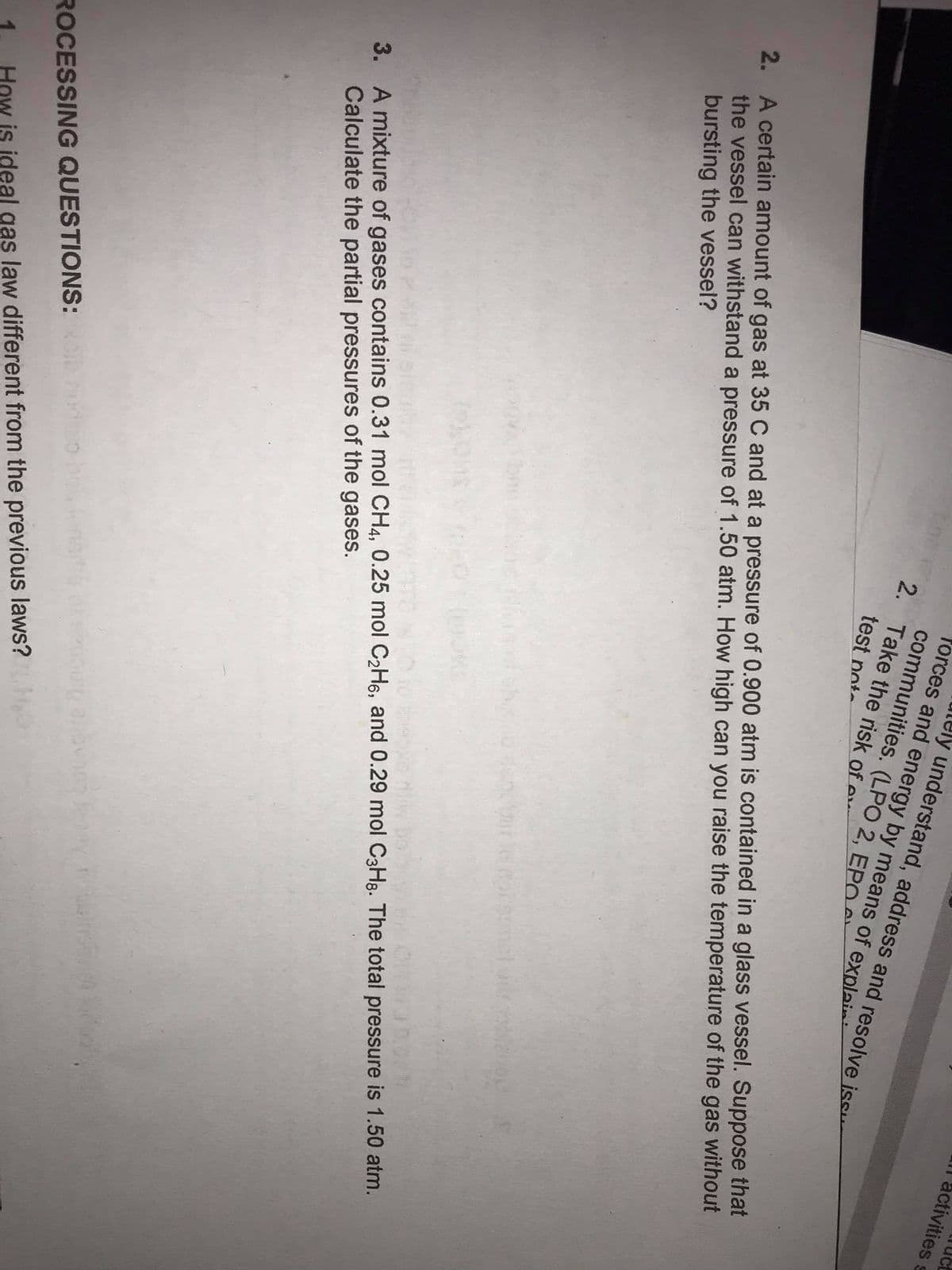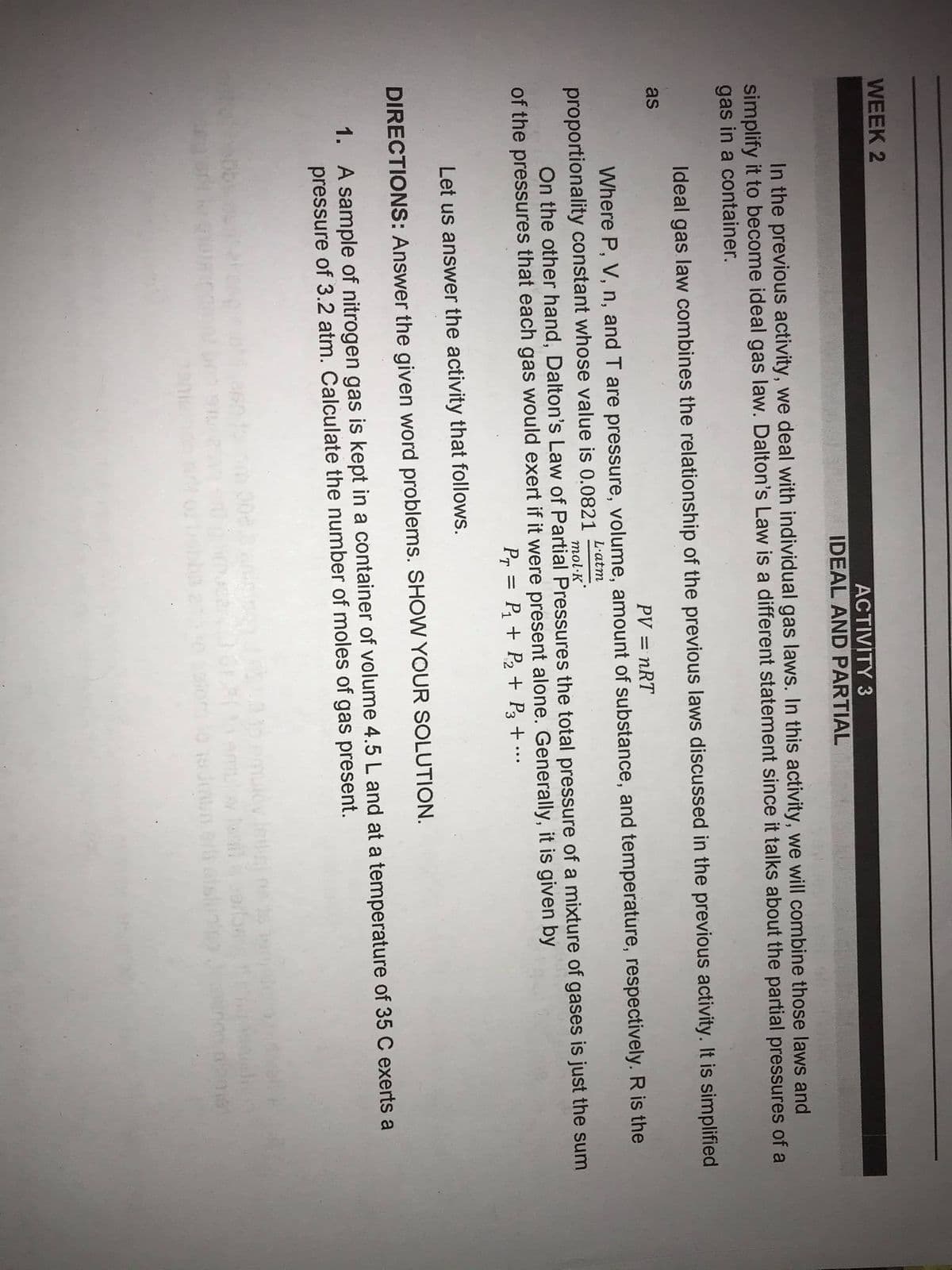2. A certain amount of gas at 35 C and at a pressure of 0.900 atm is contained in a glass vessel. Suppose that the vessel can withstand a pressure of 1.50 atm. How high can you raise the temperature of the gas without bursting the vessel? 3. A mixture of gases contains 0.31 mol CH4, 0.25 mol C2H6, and 0.29 mol C3H8. The total pressure is 1.50 atm. Calculate the partial pressures of the gases.
2. A certain amount of gas at 35 C and at a pressure of 0.900 atm is contained in a glass vessel. Suppose that the vessel can withstand a pressure of 1.50 atm. How high can you raise the temperature of the gas without bursting the vessel? 3. A mixture of gases contains 0.31 mol CH4, 0.25 mol C2H6, and 0.29 mol C3H8. The total pressure is 1.50 atm. Calculate the partial pressures of the gases.
Chemistry: An Atoms First Approach
2nd Edition
ISBN:9781305079243
Author:Steven S. Zumdahl, Susan A. Zumdahl
Publisher:Steven S. Zumdahl, Susan A. Zumdahl
Chapter8: Gases
Section: Chapter Questions
Problem 31Q
Related questions
Question

Transcribed Image Text:l activities s
ely understand, address and resolve iss
forces and energy by means of explaii
communities. (LPO 2, EPO
2. Take the risk of e
test pot-
2. A certain amount of gas at 35 C and at a pressure of 0.900 atm is contained in a glass vessel. Suppose that
the vessel can withstand a pressure of 1.50 atm. How high can you raise the temperature of the gas without
bursting the vessel?
3. A mixture of gases contains 0.31 mol CH4, 0.25 mol C2H6, and 0.29 mol C3H8. The total pressure is 1.50 atm.
Calculate the partial pressures of the gases.
ROCESSING QUESTIONS:
How is ideal gas law different from the previous laws?

Transcribed Image Text:WEEK 2
ACTIVITY 3
IDEAL AND PARTIAL
In the previous activity, we deal with individual gas laws. In this activity, we will combine those laws and
simplify it to become ideal gas law. Dalton's Law is a different statement since it talks about the partial pressures of a
gas in a container.
Ideal gas law combines the relationship of the previous laws discussed in the previous activity. It is simplified
as
PV = nRT
Where P, V, n, and T are pressure, volume, amount of substance, and temperature, respectively. R is the
L·atm
proportionality constant whose value is 0.0821
mol·K
On the other hand, Dalton's Law of Partial Pressures the total pressure of a mixture of gases is just the sum
of the pressures that each gas would exert if it were present alone. Generally, it is given by
Pr = P + P, + P3 + .….
Let us answer the activity that follows.
DIRECTIONS: Answer the given word problems. SHOW YOUR SOLUTION.
1. A sample of nitrogen gas is kept in a container of volume 4.5 L and at a temperature of 35 C exerts a
pressure of 3.2 atm. Calculate the number of moles of gas present.
008
Expert Solution
This question has been solved!
Explore an expertly crafted, step-by-step solution for a thorough understanding of key concepts.
This is a popular solution!
Trending now
This is a popular solution!
Step by step
Solved in 4 steps

Recommended textbooks for you

Chemistry: An Atoms First Approach
Chemistry
ISBN:
9781305079243
Author:
Steven S. Zumdahl, Susan A. Zumdahl
Publisher:
Cengage Learning


Chemistry
Chemistry
ISBN:
9781305957404
Author:
Steven S. Zumdahl, Susan A. Zumdahl, Donald J. DeCoste
Publisher:
Cengage Learning

Chemistry: An Atoms First Approach
Chemistry
ISBN:
9781305079243
Author:
Steven S. Zumdahl, Susan A. Zumdahl
Publisher:
Cengage Learning


Chemistry
Chemistry
ISBN:
9781305957404
Author:
Steven S. Zumdahl, Susan A. Zumdahl, Donald J. DeCoste
Publisher:
Cengage Learning

General Chemistry - Standalone book (MindTap Cour…
Chemistry
ISBN:
9781305580343
Author:
Steven D. Gammon, Ebbing, Darrell Ebbing, Steven D., Darrell; Gammon, Darrell Ebbing; Steven D. Gammon, Darrell D.; Gammon, Ebbing; Steven D. Gammon; Darrell
Publisher:
Cengage Learning

Introduction to General, Organic and Biochemistry
Chemistry
ISBN:
9781285869759
Author:
Frederick A. Bettelheim, William H. Brown, Mary K. Campbell, Shawn O. Farrell, Omar Torres
Publisher:
Cengage Learning

Introductory Chemistry: A Foundation
Chemistry
ISBN:
9781337399425
Author:
Steven S. Zumdahl, Donald J. DeCoste
Publisher:
Cengage Learning